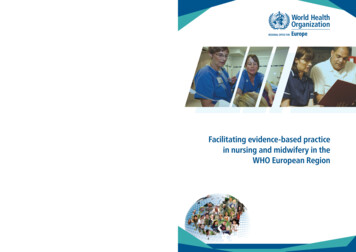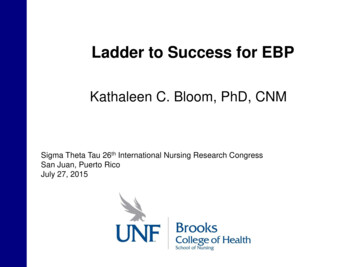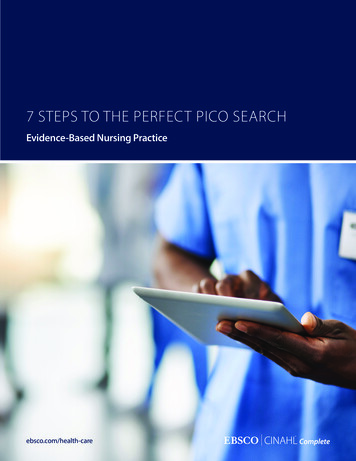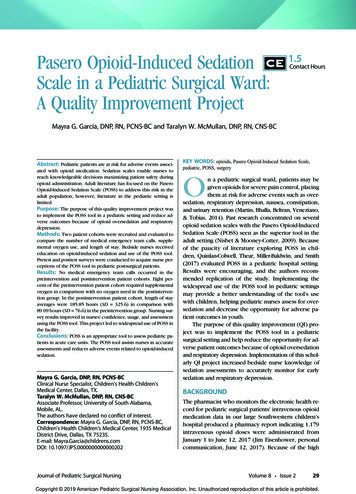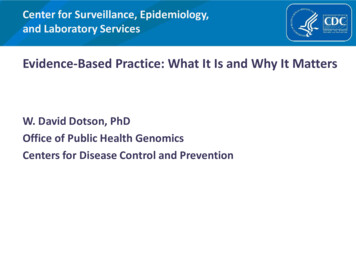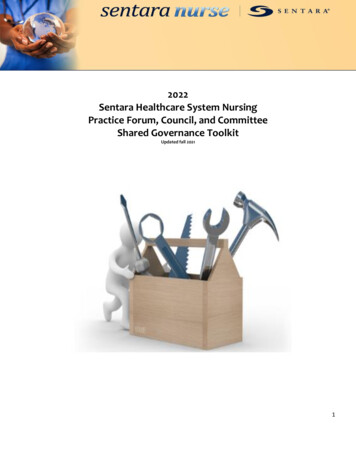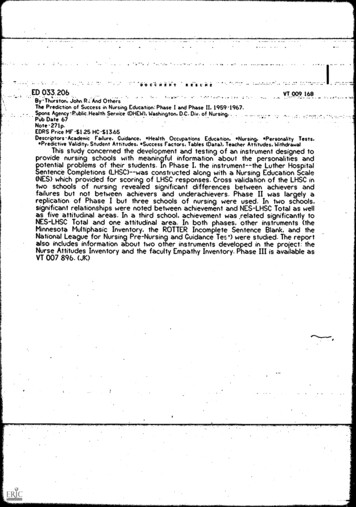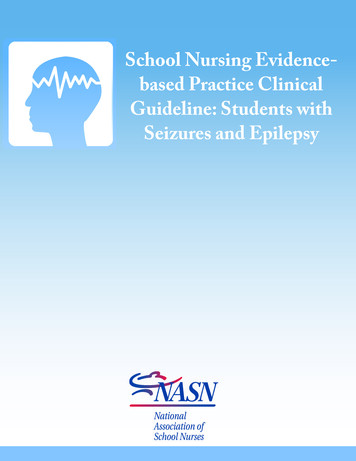
Transcription
School Nursing Evidencebased Practice ClinicalGuideline: Students withSeizures and Epilepsy
School Nursing Evidence-based Practice ClinicalGuideline: Students with Seizures and EpilepsyProject lead and authorAngela Lepkowski, DNP, RN, NCSN, PHNA-BCClinical Instructor and Course CoordinatorUniversity of Illinois at Chicago College of NursingChicago, ILNASN would like to sincerely thank the following reviewers for their valuable contributions in thedevelopment of this guideline. Review contributions do not mean endorsement.Epilepsy Foundation, Representatives from Professional Advisory BoardLandover MDNancy Antonini BSN, RN, PEL-CSNSchool Nurse, Lincoln-Way Area Special Education 843Frankfort, ILJoan K Austin PhD, RN, FAANDistinguished Professor EmeritaIndiana University School of NursingIndianapolis, INSara M. Bode MDMedical Director School Health Services, Nationwide Children’s HospitalColumbus, OHDenise Buffin MSN, MEd, RN, NCSNSchool Nurse, Brandywine School DistrictWilmington, DECynthia Hiltz, MS, RN, PHN, NCSN, FNASNAnoka-Hennepin Health Service CoordinatorAnoka, MNRon Marino DO, MPHAssociate Chair, Pediatrics at NYU WinthropPediatric Residency Program Director, Good Samaritan Hospital Medical CenterProfessor Clinical Pediatrics, Stony Brook School of MedicineNew YorkNational Association of School Nurses. (2018). School nursing evidence-based practice clinicalguideline: Students with seizures and epilepsy. Silver Spring, MD: Author.
Jan Olson MSNEd, BSN, RNDistrict Nurse, Molalla River and Colton School DistrictsMolalla and Colton, ORBrenna Quinn PhD, RN, NCSN, CNEAssistant Professor, University of Massachusetts LowellLowell, MAAndrea L. Tanner, MSN, RN, NCSNCoordinator of Health Services, New Albany Floyd CountyNew Albany, INThe author and reviewers listed above disclose the absence of a conflict of interest (direct financialcommercial, noncommercial, intellectual or institutional) relevant to the development of the School NursingEvidence-based Practice Clinical Guidelines: Students with Seizures and Epilepsy.Disclaimer:This Guideline is intended as a decision-making tool to guide professional school nurses in implementingthe most recent, evidence-based practice recommendations as of the date of publication. The results offuture studies may require revisions to this guideline to reflect new scientific data.This Guideline is not intended to create a rule or legal standard of care, nor should it be interpreted asencouraging, advocating, requiring or discouraging any particular treatment. All decisions regarding careof students should be made by the health care team, family and student in consideration of the student’sparticular health and circumstances, clinical presentation, and authorized policies. Clinical decisionsinvolve the application of nursing judgment to the student’s condition and available courses of action.Neither NASN nor its officers, directors, members, employees or agents will be liable for any loss, damage,or claim with respect to any liabilities, including direct, special, indirect or consequential damages, incurredin connection with this Guideline or reliance on the information presented in it.All evidence-based clinical guidelines from the National Association of School Nurses will automatically expire fiveyears after publication unless reaffirmed, revised, or retired at or before that time.Copyright (2018) by the National Association of School Nurses. All rights reserved. This publicationis protected by copyright. No part of it may be reproduced in any form without the written permissionfrom the publisher. Permission of NASN is required for all derivative works, including compilations andtranslations.
RationaleSeizures result from unpredictable, abnormal electrical brain activity that causes a range ofmild to severe symptoms and clinical manifestations; epilepsy is a chronic condition that involvesrecurrent seizures (Sirven & Shafer, 2014). Failure to effectively treat and manage seizures canhave serious consequences, ranging from elevated healthcare costs to poor health outcomes,including status epilepticus, permanent neurologic devastation, and death (Hartman et al., 2016).Approximately 470,000 children ages 6–17 years old in the United States have epilepsy, with aprevalence rate of 6.3/1,000 (Zack & Kabou, 2017). Fifteen percent of U.S children have specialhealthcare needs, and 3% of these are diagnosed with epilepsy (Pastor, Reuben, Kobau, Helmers,& Lukacs, 2015; U.S. Department of Health and Human Services, 2013).Children and adolescents with epilepsy incur 9,103.25 per child annually in healthcarecosts compared to their counterparts without epilepsy (Miller, Coffield, Leroy, & Wallin, 2016).This cost burden can increase exponentially if seizure first aid is not administered per the child’shealthcare provider seizure action plan. Further, children with epilepsy miss more days of school,experience more difficulty with fine and gross motor function, and receive more special educationservices compared to children without epilepsy (Pastor et al., 2015; Russ, Larson, & Halfon,2012). These functional and academic components significantly impact learning among thesestudents.The complex and unique healthcare needs of school children with epilepsy are notconsistently met in the school setting due to issues related to discordant school nursing care,knowledge deficits related to seizure management among school personnel, and medicationdelegation barriers (Hartman et al., 2016). These challenges and barriers can potentiallycontribute to increased healthcare costs, less than optimal health outcomes, and lower academicoutcomes for students with epilepsy. Additionally, the lack of a school nursing-specific clinicalpractice guideline leaves school nurses ill-equipped to effectively and safely address seizures andepilepsy in the school setting and also hinders the ability of school nurses to provide standardizedcare and systematically measure outcomes. This clinical practice guideline will provide evidencebased best practice recommendations for school nurses, thereby improving the health and safetyof students with seizures and epilepsy.1 School Nursing Evidence-Based Clinical Practice Guideline: Students With Seizures and Epilepsy
PurposeThe purpose of this clinical practice guideline is to provide the professional school nurse withevidence-based practice recommendations for high-quality care of students with seizure disordersand epilepsy. Implementation of this guideline will assist school nurses in improving the healthand safety of students with epilepsy—subsequently enhancing learning and academic success—byachieving the following outcomes: Increasing the number of students with epilepsy who have an emergency care plan and Improving seizure first aid and care management provided by school nurses and schoolaccess to prescribed emergency medications in the school setting.personnel. Decreasing unnecessary emergency room visits. Decreasing the number of inpatient hospital admissions among students with seizures Increasing return to class when safe and appropriate (e.g., student returns to baseline).and epilepsy who receive rescue medication in the school setting, when indicated.Note that the care of students with seizures and epilepsy is highly complex, individualized,and directed by healthcare provider (e.g., neurologist, epileptologist, primary care providerphysician or nurse practitioner) treatment recommendations and orders. Specific complextreatment regimens established by the healthcare team will not be discussed in detail within thisguideline. Rather, this guideline is intended as an overview to guide professional school nursesin implementing provider-developed treatment regimens, as well as to apply nursing judgmentbased on students’ individual needs within the domains of education/training, care plans, carecoordination, special education, and rescue medication. Specific seizure and epilepsy disordersas well as implications specific to complex treatment regimens are beyond the scope of thisclinical practice guideline. In addition, this guideline outlines steps specific to seizure disorders.Other activities carried out by a school nurse for students with chronic conditions should stillbe completed but are not included in this guideline. Such activities may include assessing andaddressing student developmental stage and social determinants of health, developing student/family goals, and providing student-specific education/empowerment.2 School Nursing Evidence-Based Clinical Practice Guideline: Students With Seizures and Epilepsy
This Guideline is intended as a decision-making tool to guide professional school nurses inimplementing the most recent, evidence-based practice recommendations as of the date ofpublication. The results of future studies may require revisions to this guideline to reflect newscientific data.This Guideline is not intended to create a rule or legal standard of care, nor should it beinterpreted as encouraging, advocating, requiring or discouraging any particular treatment. Alldecisions regarding care of students should be made by the health care team, family and studentin consideration of the student’s particular health and circumstances, clinical presentation,and authorized policies. Clinical decisions involve the application of nursing judgment to thestudent’s condition and available courses of action.Neither NASN nor its officers, directors, members, employees or agents will be liable forany loss, damage, or claim with respect to any liabilities, including direct, special, indirector consequential damages, incurred in connection with this Guideline or reliance on theinformation presented in it.MethodologyThis evidence-based clinical practice guideline was developed according to the NationalAssociation of School Nurses (NASN) Model for Developing School Nursing Evidence-BasedPractice Clinical Guidelines.Definitions and Abbreviations of Terms504: Plan developed under Section 504 of the Rehabilitation Act of 1973.CDC: Centers for Disease Control and Prevention.Children With Special Healthcare Needs: Defined by the U.S. Department of Health andHuman Services, Health Resources and Services Administration, Maternal and Child HealthBureau, as “those who have or are at increased risk for a chronic physical, developmental,behavioral, or emotional condition and who also require health and related services of a type oramount beyond that required by children generally” (U.S. Department of Health and Humanservices, 2013, p. 9).CPG: Clinical Practice Guideline.EBP: Evidence-Based Practice.ECP: Emergency Care Plan. This plan is developed by the registered professional school nurseusing clear terminology that can be easily understood by school personnel and non-medical3 School Nursing Evidence-Based Clinical Practice Guideline: Students With Seizures and Epilepsy
professionals. The ECP outlines the action steps involved in recognizing and responding to ahealth crisis. Development of an ECP is vital in the absence of an HCP SAP. An ECP uses themedical information found in the SAP and expands it to include nursing considerations andschool-site-specific processes, such as where medication is stored, who will do what, and whatprocedures school personnel should follow.EMS: Emergency Medical Services.ER: Emergency Room.HCP: Healthcare provider; includes neurologist, epileptologist, or primary care provider(physician or nurse practitioner) responsible for diagnosis and medical treatment.IEP: Individualized Education Program developed under the Individuals with DisabilitiesEducation Act. (IDEA, 2004).IHP: Individualized Healthcare Plan. NASN’s position is that the IHP is “developed by theschool nurse using the nursing process in collaboration with the student, family and healthcareproviders. The school nurse utilizes the IHP to provide care coordination, to facilitate themanagement of the student’s health condition in the school setting, to inform school-educationalplans, and to promote academic success” (NASN, 2015, final paragraph). An IHP uses themedical information found in the SAP and expands it to include nursing considerations beyondemergencies, such as student and family goals and educational needs as well as school-sitespecific processes.IOM: Institute of Medicine. In 2015, the name was changed to the National Academy ofMedicine.Least Restrictive Medication: A medication that is administered via the least invasive route.Rectal administration is invasive, while buccal and intranasal routes are noninvasive.SAP: Seizure Action Plan. This plan is typically completed by the healthcare team and includesparameters for emergency care in the event of a prolonged seizure as well as prescribed rescuemedications and instructions for use. The school nurse often uses this SAP to develop anindividualized and/or emergency care plan.Special Education Services: Free and appropriate education for children with disabilitiesthat is designed to meet their unique needs and is administered by means of an IndividualizedEducation Program (IDEA, 2004).UAP: Unlicensed Assistive Personnel.4 School Nursing Evidence-Based Clinical Practice Guideline: Students With Seizures and Epilepsy
Search and Selection of Relevant LiteratureThe systematic literature search and selection was conducted according to the stepsoutlined in the Model for Developing School Nursing Evidence-Based Clinical Practice Guidelines.Once a body of literature was located, the EBP Guideline Evidence Decision Tree (AppendixA) was applied to ensure inclusion of only strong, high-quality, relevant evidence. The first stepof the decision tree is the application of Quick Filter Criteria: Reputable source? Relevant topopulation? Applicable to practice? Literature that met these criteria was further evaluated andgraded. Fifty-five articles and EBP resources were obtained in the collective search; Quick FilterCriteria were applied, resulting in 27 articles and EBP resources for critical appraisal in the finalbody of evidence. The final body of evidence represents the most recent, applicable, and bestavailable articles related to school nursing practice.The academic database PubMed was searched using MeSH subject headings (i.e.,epilepsy, children, healthcare, and prevalence) to establish the prevalence and impact of epilepsyamong school-age children. Next, several key word searches were conducted in CINAHL,PubMed, and Educational Resources Information Center (ERIC) databases to review literaturerelevant to both stable and acute management of epilepsy, the management of epilepsy in schooland community settings, and the role of healthcare providers and professionals in managingepilepsy. The first search within CINAHL included the following search terms: seizures ANDepilepsy, children, school. Two key word searches were performed in PubMed with the followingsearch terms: (1) seizures AND epilepsy, emergency treatment, schools; (2) seizure guidelineAND children AND school OR community. These searches yielded a total of eight and fourarticles, respectively. Lastly, key word searches were performed in ERIC to capture epilepsyresearch within education-related literature. The key word searches included the following terms:(1) epilepsy OR seizures AND management AND children NOT adults; (2) epilepsy ORseizures AND emergency AND children NOT adults. Fourteen and eight articles were obtained,respectively, from these searches. The limits of English language and date (excluding articlespublished prior to 2007) were applied to all keyword searches in each database. Duplicates wereremoved, and the combined searches yielded 44 documents.A hand search of reference lists was performed to build upon the body of evidencecaptured in the database searches. Additionally, the Agency for Healthcare Research andQuality’s National Guideline Clearinghouse and the National Institute for Health and CareExcellence (NICE) were explored to identify existing evidence-based clinical practice guidelinesrelated to epilepsy management in the school setting. This search did not result in any guidelines5 School Nursing Evidence-Based Clinical Practice Guideline: Students With Seizures and Epilepsy
focused on managing epilepsy in the school setting specifically, but one general epilepsymanagement guideline was included (NICE, 2016), as relevant information to management innon-acute settings and communities was contained within the guideline; these recommendationsare applicable to the school environment. Additionally, the American Association ofNeuroscience Nurses (2016) “Care of Adults and Children with Seizures and Epilepsy” ClinicalPractice Guideline was also included in the body of evidence. Further, the websites of the Centersfor Disease Control and Prevention (CDC), the National Association of School Nurses (NASN),the Epilepsy Foundation, the American Epilepsy Society (AES), and the International LeagueAgainst Epilepsy (ILAE) were searched to locate evidence-based materials such as expert panelrecommendations, position statements, toolkits, and training resources specific to the care andmanagement of children with seizures and epilepsy.Critical Appraisal of EvidenceThe final body of evidence was critically appraised to establish level, quality, and subsequentstrength of practice recommendations (Appendix B). A panel of experts, including members ofthe Professional Advisory Board of the Epilepsy Foundation, practicing expert school nurses, andphysicians, reviewed and contributed to the evidence appraisal and practice recommendations.The panel used the AGREE II Instrument to assess the quality of the guideline andrecommendations for use. NASN also completed an independent review.Translation Into Practice RecommendationsThe following practice recommendations are based on the most recent, quality evidence to informprofessional school nursing care of students with seizures and epilepsy. Recommendations areorganized by the following domains of care: care coordination, clinical guidelines, education/training, rescue medication, seizure action plan, and special education.6 School Nursing Evidence-Based Clinical Practice Guideline: Students With Seizures and Epilepsy
School Nursing Evidence-based Practice Clinical Guideline:Students With Seizures and Epilepsy Translation Into Practice RecommendationsSchool Nursing Evidence-Based Practice GuidelineDomains of CareASSESSMENTA: 24, 25The professional school nurse will assess: Student health history.Care CoordinationA: 17, 24, 25 Family and caregiver knowledge, engagement, coping and compliance in caring for thestudent with seizures and epilepsy.Education/TrainingA: 17, 24, 25 Presence of Seizure Action Plan. Presence of physical/medical co-morbidities, social/familial isolation, behavior/mentalhealth concerns, and developmental/cognitive delays and disorders.Seizure Action Plan Medication administration to allow for delegation of rescue medicationadministration to UAP (if allowed per state/local policies), or plan formedication administration in absence of school nurse.B: 15, 16C: 1, 3, 10, 19, 21, 22 School and district policies, protocols, and procedures related to: Seizure and epilepsy training, including seizure first aid training. B: 5, 15, 16C: 1, 2, 3, 4, 10, 18,19, 20, 21, 22, 27 Student baseline seizure type and activity, including antecedents, presentation,frequency, and severity. Rescue medication accessibility, if indicated.B: 9, 11, 16C: 1, 4, 12, 18, 20,21, 22 Annually assess student access to a medical home and specialized care, includingphysical access to care and medical coverage. Mechanism or plan for communication with HCP.References byStrength* (A, B, C)(See Appendix B)A: 6, 24, 25Rescue MedicationMedical emergency preparedness and response.B: 8, 15, 16C: 1, 7, 14, 18, 22, 27*This Guideline is intended to be a decision-making tool and doesn’t replace clinical nursing judgement (see full disclosure).7 School Nursing Evidence-Based Clinical Practice Guideline: Students With Seizures and Epilepsy 2018 NASN
School Nursing Evidence-Based Practice GuidelineDomains of CareNURSING DIAGNOSES Risk forffective airway clearance among students with seizures and epilepsy, asevidenced by accumulation of secretions during seizure.References byStrength* (A, B, C)(See Appendix B)A: 24, 25Care CoordinationB: 9, 11, 16 Risk for injury among students with seizures and epilepsy, as evidenced byenvironmental factors present during seizure, lack of SAP and/or IHP; secondary toseizure first aid knowledge deficit.C: 1, 4, 12, 18, 20,21, 22 Risk for social isolation among students with seizures and epilepsy, as evidenced byunpredictability of seizures,community-imposed stigma.A: 17, 24, 25 Risk for delayed development among students with seizures and epilepsy, asevidenced by potential neurological deficits.Education/TrainingC: 1, 2, 3, 4, 10, 18,19, 20, 21, 22, 27 Ineffective therapeutic regimen management among students with seizures andepilepsy related to complexity of therapeutic regimen, knowledge deficit, perceivedbarriers, and powerlessness, as evidenced by student-specific assessment findings. Ineffective community therapeutic regimen management among school personnelrelated to lack of knowledge of seizure first aid and management of students withepilepsy, as evidenced by reported lack of confidence and understanding in workingwith students with epilepsy.A: 6, 24, 25Rescue MedicationA: 17, 24, 25The student will:Education/TrainingB: 5, 15, 16C: 1, 2, 3, 4, 10, 18,19, 20, 21, 22, 27 Receive seizure first aid while experiencing a seizure in the school setting. (SeeAppendix C for Seizure First Aid Recommendations).A: 17, 24, 25 Experience reduced risk of injury during the school day, including school-providedtransport. Remain free from injury while experiencing a seizure in the school setting.B: 8, 15, 16C: 1, 7, 14, 18, 22, 27OUTCOMES IDENTIFICATION Receive health and educational support by means of an SAP, ECP, IHP, 504 Plan, orIEP.B: 5, 15, 16B: 15, 16Seizure Action Plan Return to class following a baseline seizure, if vital signs are stable and post-ictalphase has resolved.C: 1, 3, 10, 19, 21, 22*This Guideline is intended to be a decision-making tool and doesn’t replace clinical nursing judgement (see full disclosure).8 School Nursing Evidence-Based Clinical Practice Guideline: Students With Seizures and Epilepsy 2018 NASN
School Nursing Evidence-Based Practice GuidelineDomains of Care Receive rescue medication as ordered by HCP and outlined in SAP. Be transported to the emergency room for assessment and treatment via EMS if: The seizure continues five minutes after rescue medication has beenadministered, or as otherwise specified by HCP. This is the student’s first episode requiring rescue medication, in students withhistory of frequent serial seizures or convulsive status epilepticus. The student experiences any concerns with airway, breathing, circulation, orother vital signs. The student experiences a seizure in water or sustains a traumatic injury as aresult of the seizure. The student experiences a first-time seizure.The professional school nurse will:A: 6, 24, 25Rescue Medication Develop a modifiable, customizable ECP and /or IHP template that includes stepsfor basic seizure first aid, other student considerations, and school-site specificconsiderations. In collaboration with primary HCP or medical home, refer student with suspected oractual seizures and epilepsy to specialty care provider, or to the most qualified providerwith experience in pediatric neurology if access to specialty care providers is limited. Advocate for the least restrictive medication choice (buccal or nasal rather than rectal)in the child’s environment: Buccal midazolam is recommended as first-line treatment in children withprolonged seizures in the community (school) setting.A: 23, 24, 26Special EducationB: 11C: 12, 22A: 24, 25Care CoordinationB: 9, 11, 16C: 1, 4, 12, 18, 20,21, 22A: 13Clinical PracticeGuidelinesB: 16C: 21A: 17, 24, 25Education/Training Collaborate with families/caregivers, student, and HCP to develop a comprehensive,mutually agreed upon IHP to be implemented in the school setting. Consult and collaborate with student in planning IHP and health-related goals toincrease self-advocacy and self-management of seizures and epilepsy.B: 8, 15, 16C: 1, 7, 14, 18, 22, 27PLANNING Collaborate with HCP to obtain an SAP and orders for use in the school setting.(Click here for example).References byStrength* (A, B, C)(See Appendix B)B: 5, 15, 16C: 1, 2, 3, 4, 10, 18,19, 20, 21, 22, 27A: 23, 24, 26Seizure Action PlanB: 15, 16C: 1, 3, 10, 19, 21, 22*This Guideline is intended to be a decision-making tool and doesn’t replace clinical nursing judgement (see full disclosure).9 School Nursing Evidence-Based Clinical Practice Guideline: Students With Seizures and Epilepsy 2018 NASN
School Nursing Evidence-Based Practice Guideline Develop an IHP to address the student’s individual needs related to seizures andepilepsy, including (but not limited to): Avoidance of seizure triggers/antecedents. Anti-epileptic drug side effects, such as drowsiness, fatigue, nausea, anorexia,headaches, hyperactivity, somnolence, gastrointestinal upset, and rash. Use (including parameters, instructions, and delegation/training, if applicable)of a Vagal Nerve Stimulator (VNS), as outlined in HCP orders. Dietary modifications, as indicated by HCP orders, and mechanism to assiststudent adherence to diet. Recording of seizure occurrence and/or seizure-like activity in an observationlog (may be done by school nurse, teacher, or other trained individual) andcommunicating events to families/caregivers and HCP. Observation log should include date/time of occurrence anddescription of what happened before (pre-ictal), during (ictal), andafter (post-ictal) the event. Develop a 504 plan with accommodations or IEP health recommendations/modifications/goals to ensure that the student can access the educationalenvironment in the same manner as nondisabled peers. This may include: Access to an individual paraprofessional classroom aide. Ensuring access to a professional school nurse for assessment, treatment, andmonitoring. Testing accommodations based on individual student’s needs, as assessed bythe school nurse, if indicated. Transportation recommendations.The professional school nurse will:Domains of CareRescue MedicationReferences byStrength* (A, B, C)(See Appendix B)A: 17, 24, 25B: 8, 15, 16C: 1, 7, 14, 18, 22, 27A: 23, 24, 26B: 11Special EducationIMPLEMENTATIONC: 12, 22A: 24, 25B: 9, 11, 16Care Coordination Develop policies, protocols, and/or procedures related to:C: 1, 4, 12, 18, 20, Seizure and epilepsy training, including seizure first aid training.21, 22 Medication administration to allow for delegation of rescue medicationA: 13administration (if allowed per state/local policies) or plan for medicationB: 16Clinical Practiceadministration in absence of school nurse.Guidelines Delegation and procedure for use of VNS magnet (if allowed per state/localC: 21policies).*This Guideline is intended to be a decision-making tool and doesn’t replace clinical nursing judgement (see full disclosure).10 School Nursing Evidence-Based Clinical Practice Guideline: Students With Seizures and Epilepsy 2018 NASN
School Nursing Evidence-Based Practice Guideline Resources and support to ensure adherence to special diets.Medical emergency preparedness and response plan specific to seizureemergencies.Domains of CareEducation/Training Implement SAPs/ECPs, IHPs, 504 plans, and IEPs as appropriate, communicatingwith student, family/caregivers, education, team, and HCP to improve and revise asneeded. Collaborate with families/caregivers, school administrators, and HCP to identify andtrain school personnel to administer rescue medication in the absence of the schoolnurse, in accordance with district policies, competency training and criteria, and stateNurse Practice Act and Rules. Provide evidence-based seizure and epilepsy education and training, including seizurefirst aid, to school teachers and staff. If unable to provide education directly, arrangefor in-person or online training to be provided through the local Epilepsy Foundation(recommended by the CDC and IOM). Such training should include student-specific considerations for schoolpersonnel who care for student directly, per IHP. Establish collaboration between school nurse, families/caregivers, and HCP to ensureconsistent communication. School nurse will communicate occurrences of seizure emergencies andrescue medication administration to families/caregivers and HCP as soon aspossible by caregivers’ preferred method of communication.Seizure Action PlanA: 6, 24, 25Rescue MedicationB: 8, 15, 16C: 1, 7, 14, 18, 22, 27A: 23, 24, 25B: 11Special EducationC: 12, 22A: 24, 25Care Coordination Number of students diagnosed with a seizure disorder/epilepsy. Number of students who have an IHP, 504 plan, or IEP to address seizure/epilepsyrelated needs in the school setting.B: 15, 16C: 1, 3, 10, 19, 21, 22 Number of students who experience a seizure in the school setting. Number of students who have a seizure SAP (completed by HCP).C: 1, 2, 3, 4, 10, 18,19, 20, 21, 22, 27A: 17, 24, 25EVALUATIONThe professional school nurse will collect the following information and evaluate:References byStrength* (A, B, C)(See Appendix B)A: 17, 24, 25B: 5, 15, 16B: 9, 11, 16C: 1, 4, 12, 18, 20,21, 22A: 23, 24, 25Clinical PracticeGuidelinesB: 11C: 12, 22*This Guideline is intended to be a decision-making tool and doesn’t replace clinical nursing judgement (see full disclosure).11 School Nursing Evidence-Based Clinical Practice Guideline: Students With Seizures and Epilepsy 2018 NASN
School Nursing Evidence-Based Practice GuidelineDomains of Care Student and family/caregiver sa
1 School Nursing Evidence-Based Clinical Practice Guideline: Students With Seizures and Epilepsy Rationale Seizures result from unpredictable, abnormal electrical brain activity that causes a range of mild to severe symptoms and clinical manifestations; epilepsy is a chronic condition that involves recurrent seizures (Sirven & Shafer, 2014).
